Today’s recipe is bibimbap, a super-popular Korean dish you might have heard about already! It’s made of a bowl of rice, sautéed and seasoned vegetables (namul: 나물), a bit of hot pepper paste (gochujang: 고추장), and usually a bit of seasoned raw beef, too (yukhoe: 육회).
Bibim (비빔) translates as “mixed,” and bap (밥) means “cooked rice,” so bibimbap literally means “mixed rice.” Before eating it you’re supposed to mix everything all together.
There are many variations on this dish, from simple to elaborate, and this recipe I’m showing you today is for one you could consider “classic” bibimbap. If you ordered bibimbap in a Korean restaurant, you would probably get something like this dish, with regional variations. I’m also going to show you bibimbap prepared and served in a heated stone or earthenware bowl called dolsot-bibimbap (돌솥비빔밥). “Dolsot” means “stone pot” in Korean, and this version is well-known for the way the bowl makes a layer of crispy, crackling rice on the bottom of the bibimbap.
Even though we mix up bibimbap before we eat it, each ingredient needs to be prepared with care and individuality, bringing out their unique flavors, textures and colors so they come together beautifully in the bowl and deliciously in your mouth. The different ingredients aren’t random, they’re chosen because they balance, harmonize, and offset each other.
This recipe isn’t quick and easy, it takes some time to make. But if you’re really in a rush you can make a great bibimbap with the soybean sprouts, spinach, and carrot (or red bell pepper, or both), and gochujang, toasted sesame oil, and an egg— those items are unskippable!
I’m going to share some more bibimbap recipes on my website in the future, and you’ll see how many different variations there are. This version is a little different than the version in my cookbook, because I make a quick and simple soup with the bean sprouts. When I started my YouTube channel, bibimbap was one of the first recipes I made, because it’s such an essential dish in Korean cuisine. So I’m happy to remake the video now in HD with much better editing and instruction. I’ve been building up to this video by remaking videos for the ingredients, too. I remade yukhoe, and sigeumchi-namul, and my yukagaejang video has a lot of detail about preparing the mountain vegetable fernbrake.
So if you’ve been following my videos, you’re now ready to be a bibimbap master! Ready? Let’s start!
Ingredients
Serves 4
- 5 cups cooked short-grain rice
- 12 ounces soy bean sprouts, washed and drained
- 8 ounces of spinach blanched and washed with the excess water squeezed out by hand
- 1 large carrot
- 1 large red bell pepper
- 1 large zucchini
- 1 English cucumber
- 3 to 4 green onions, chopped
- ½ pound fresh lean cut of beef (fillet mignon, flank steak)
- 4 ounces fernbrake (gosari), fresh or soaked from ½ ounce dried gosari (details below)
- 1 ounce dried bellflower roots (doraji), soaked in cold water for 18 to 24 hours.
- 4 eggs
- kosher salt
- vegetable oil
- toasted sesame oil
- toasted sesame seeds
- garlic
- soy sauce
- honey (or sugar)
- Korean hot pepper paste (gochujang)
How to prepare dried fernbrake (gosari) for use
If you have presoaked or fresh fernbrake you can use it straight away, but if you have dried fernbrake you’ll need to get it ready to eat. It’s fast if you have a pressure cooker, but if you don’t it will take some time.
With a pressure cooker:
- Wash ½ ounce of dried gosari and boil it with 5 cups of water in a pressure cooker for 30 minutes.
- Drain and rinse in cold water a couple of times.
- Drain. It should make 4 ounces.
In a pot on the stove:
- In a large saucepan add ½ ounce of dried gosari to 7 cups of water. Bring to a boil over medium-high heat and boil for 30 minutes. Cover and let stand until cool, about 2 to 3 hours.
- Rinse the fernbrake a couple of times, drain and put in a bowl. Cover with fresh cold water and let soak for at least 8 hours or overnight in a cool place, changing the water 2 or 3 times during the soaking.
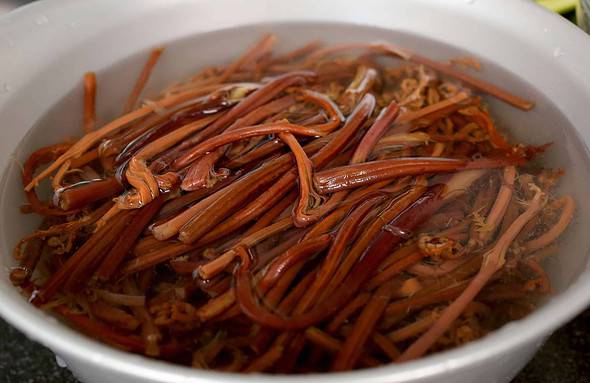
- Taste the gosari: It should be soft. If it’s tough, boil it again in a fresh pot of water for about 20 minutes and then let it sit, covered, until soft.
- Drain. It should make 4 ounces.
Make rice
If you have a usual method for making rice or have a rice cooker, go ahead and make 5 cups of rice like you usually do. But here’s how I do it on a pot on the stove. 2 cups of dried rice makes about 5 cups of cooked rice.
- Rinse 2 cups of rice in cold water and scrub the wet rice with your hand. Rinse and drain until the drained water is pretty clear.
- Put the rice in a heavy-bottomed pot. Add 2 cups of water, cover, and soak for 30 minutes.
- Cook over medium high heat for 7 to 8 minutes until the surface is covered with abundant bubbles that are spluttering noisily and look like they’re about to overflow the pot. Turn the rice over a few times with a spoon and cover the pot again.
- Turn the heat to very low and simmer for another 10 minutes until the rice is fully cooked and fluffy. Remove from the heat.
- Fluff the rice with a spoon to release excess steam. Let the rice stand, covered, at room temperature to keep it warm.
Prepare and cook the ingredients for bibimbap
I like to get a big platter and then put each vegetable on it as they’re ready. I think it looks really pretty, but you don’t have to do this. When all vegetables are prepared and ready to use, the platter looks pretty delicious!
Soybean sprouts:
- Put the soy bean sprouts in a pot and add 4 cups water and 2 or 3 teaspoons salt. Cover and cook for 20 minutes over medium high heat. Take out the sprouts with tongs and put them into a bowl, leaving about ½ cup of sprouts in the pot with the water you used to boil them. This is the soup to serve with bibimbap later.

- In a bowl, mix the sprouts by hand with ½ teaspoons salt, 1 teaspoon minced garlic, and 2 teaspoons toasted sesame oil. Put them on the large platter.
Spinach:
- Cut up the blanched spinach a few times and put it in a bowl. Mix by hand with 1 teaspoon garlic, 1 teaspoon toasted sesame oil, ½ teaspoon kosher salt, and 1 teaspoon sesame seeds. Cover and put it next to the soy bean sprouts on the platter.
Other fresh vegetables:
- Cut the carrot into matchsticks, put them in a bowl, and mix with a pinch of salt. Let stand for 5 to 10 minutes until sweating.

- Cut the red bell pepper into halves, deseed, and slice into strips. Put them in a bowl.
- Cut the zucchini into matchsticks and mix with ½ teaspoon kosher salt.
- Cut the cucumber into halves lengthwise and slice thinly crosswise. Mix with ¼ teaspoon kosher salt.
Beef:
- Cut the beef into matchsticks and put them in a bowl.
- Mix with 1 tablespoon minced garlic, 1 tablespoon soy sauce, 1 tablespoon honey, 2 teaspoons toasted sesame oil, and 1 teaspoon sesame seeds with a spoon.

- Cover and keep in the fridge until ready to use.
Mountain vegetables:
- Cut the fernbrake (gosari) a few times into bite size pieces. Set aside.
- Put the bellflower roots (doraji) in a large bowl. Add 1 or 2 tablespoons salt. Rub for a minute to wilt slightly and release some of the bitterness. Rinse them in cold water a couple of times and drain. If you find some roots are too thick, split them lengthwise. Set aside.
Let’s cook!
- Heat up a pan over medium high heat. Squeeze out excess water from the carrot. Add a few drops of cooking oil to the pan and sauté the carrot for 1 minute. Put it on the platter next to the soy bean sprouts and spinach. Clean the pan with wet paper towel or wash it.
- Heat a few drops of cooking oil in the pan and squeeze out the excess water from the cucumber. Sauté with ½ teaspoon minced garlic and a few drops of toasted sesame oil for 30 seconds. Put it on the platter. Clean the pan.
- Heat up the pan with a few drops of cooking oil. Add the red bell pepper and sprinkle a pinch of salt over top. Sauté for 30 seconds. Put it on the platter. Clean the pan.
- Heat up the pan and squeeze out excess water from the zucchini. Add a few drops of cooking oil and sauté with 1 teaspoon minced garlic, 1 tablespoon chopped green onion, a drop of toasted sesame oil for 1 minute until slightly softened. Put it on the platter. Clean the pan.
- Heat up the pan with a few drops of cooking oil. Add the bellflower roots and sauté for 2 to 3 minutes. Lower the heat to medium so as not to brown them. Add 1 teaspoon minced garlic and a drop of toasted sesame oil. Stir for another minute until a little softened. Put it on the platter. Clean the pan.

- Heat up the pan. Add a few drops of cooking oil. Stir the gosari for 2 minutes until a little softened. Add ½ teaspoon of minced garlic, 2 teaspoons soy sauce, and 2 teaspoons sugar, and keep stirring for another minute. Put it on the platter.
Serve
Here are a couple of ways to serve: bibimbap in a regular, shallow bowl, and dolsot-bibimbap in a stone or earthenware bowl.
In a regular, shallow bowl
- Reheat the soybean sprout soup.

- Divide the cooked rice into 4 portions. Each portion will be a little more than 1 cup of rice.
- Put the rice in each of 4 bowls and arrange the vegetables and beef on the rice. Top with a raw egg yolk and gochujang. If you prefer your eggs and beef cooked, use a fried egg sunny side up and slightly pan-fry the beef before putting them on the top of rice.
- Sprinkle the bibimbap with the sesame seeds and drizzle with sesame oil to taste.
- Ladle the soup to a small bowl and sprinkle some chopped green onion over top.
- Serve right away with more hot pepper paste on the side, and maybe kimchi too.

Dolsot-bibimbap in a hot earthenware bowl (ttukbaegi) or hot stone bowl (dolsot)
- Reheat the soybean sprout soup.
- Put a few drops of toasted sesame oil in the bottom of each of 4 earthenware bowls. They should be big enough to hold 4 to 6 cups each.
- Divide the rice among the bowls. Arrange the vegetables and beef on the rice. Top each serving with a raw egg yolk and 1 tablespoon gochujang. If you prefer your eggs and beef cooked, use a fried egg sunny side up and slightly pan-fry the beef before putting them on the top of rice.
- Set each pot on a burner. Heat over medium high heat until you hear a ticking, crackling sound coming from the rice.

- Sprinkle the bibimbap with the sesame seeds, drizzle with sesame oil to taste.
- Ladle the soup to a small bowl and sprinkle some chopped green onion over top.
- Serve right away with more hot pepper paste on the side and maybe kimchi too.

Eat
Maangchi's Amazon picks for this recipe
It's always best to buy Korean items at your local Korean grocery store, but I know that's not always possible so I chose these products on Amazon that are good quality. See more about how these items were chosen.



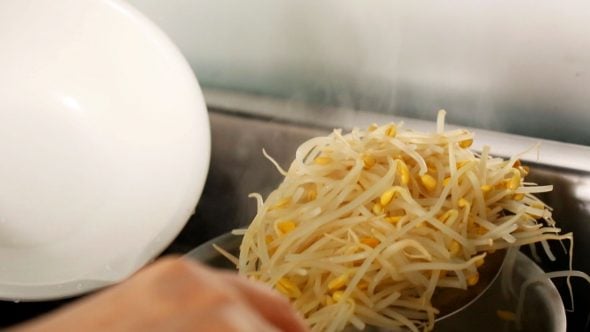
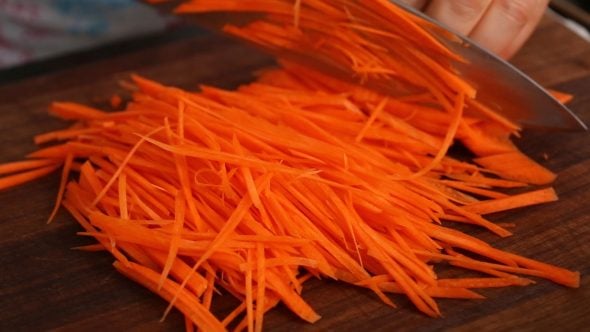
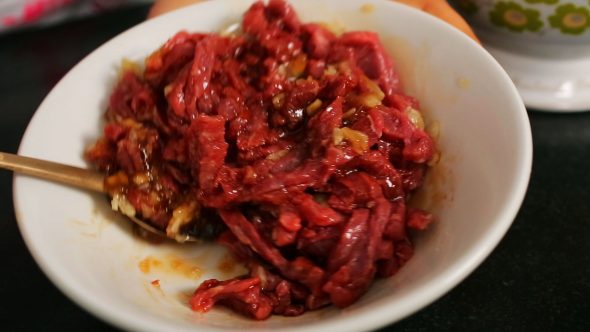
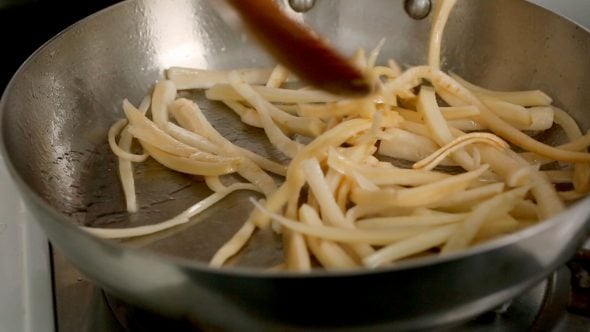
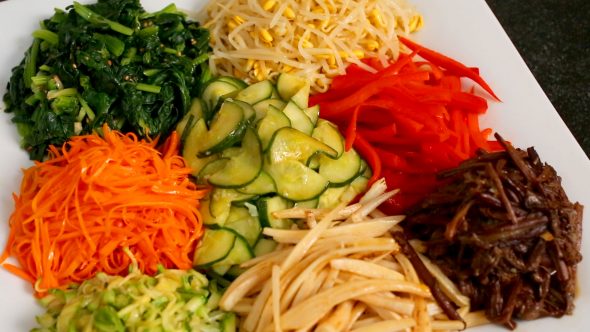
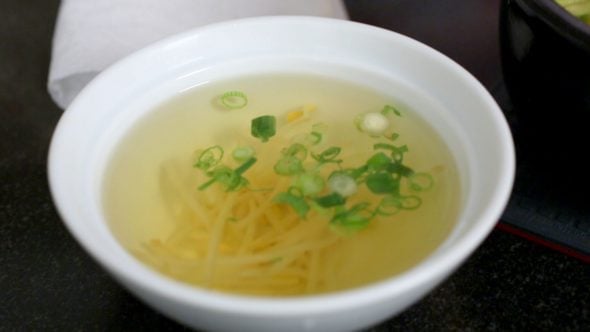
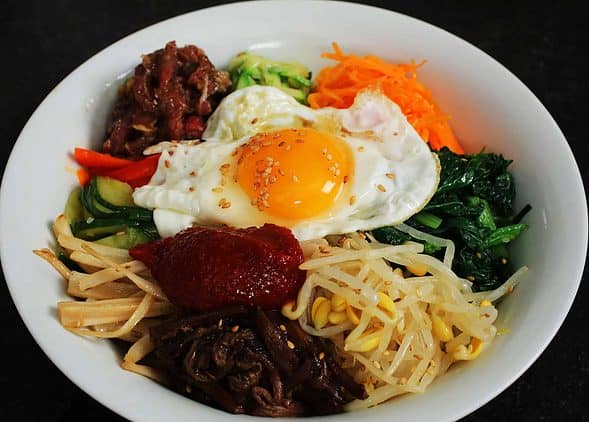

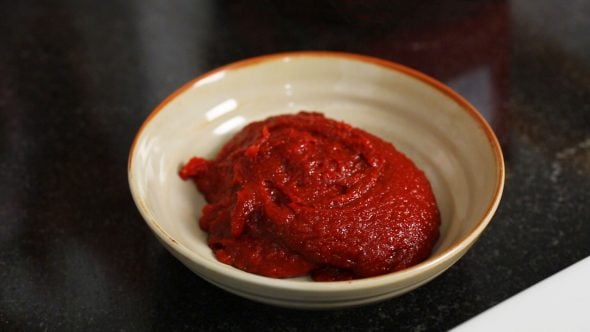
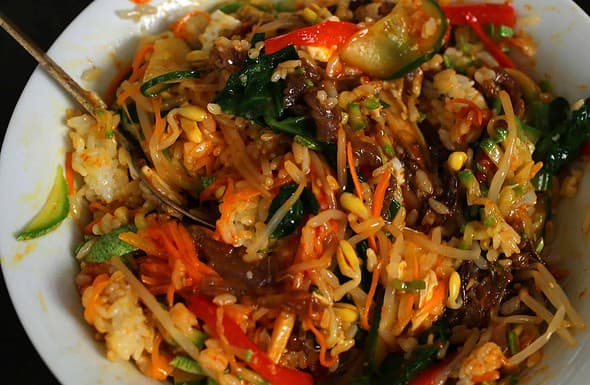






![[OTTOGI] Delicious COOKED RICE...](https://m.media-amazon.com/images/I/41zYdZ3EWJL._SL160_.jpg)


























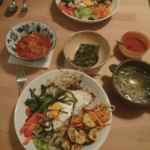
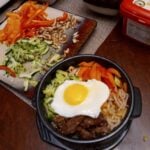
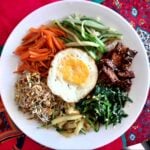
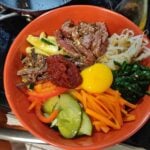
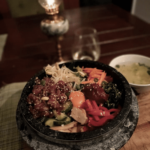
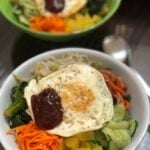


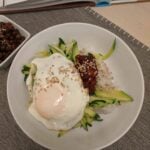
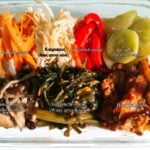
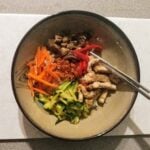
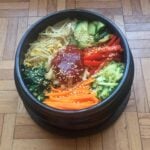

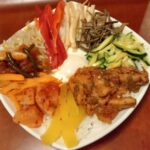

Hi Maangchi,
I would like to ask, where can I buy this ceramics pot? Are they also available in Korean grocery?thanks
https://www.maangchi.com/kitchenware/earthenware-bowl
Yes, it’s sold at a Korean grocery store.
Hubby and I made this today. Teamwork! It turned out great. The only thing I left out were the mushrooms (just because we couldn’t get to them before the baby got up from his nap). It was delicious!
yay! hubby and wife cooked together. It should be delicious! : )
this is so good, I made this today. I tried some of other recipes, your recipe is the best Kroean favourful one. I will recommend to all my friends….~~~
Thanks a lot! Happy cooking!
20 min was way too long for my bean sprouts so they were really soft! but still delicious!
http://29.media.tumblr.com/tumblr_lh2t3qf5DF1qg2a59o1_500.jpg
Your bibimbap looks very delicious! I will twit about it! : )
Bibimbap 2 weeks in a row !! Love love love this dish .. i could eat it everyday !! LOL
haha, 2 weeks in a row. Strangely I won’t get tired of eating bibimbap for 2 weeks, too. maybe not? : )
I made Bibimbap for dinner tonight! It was great!
http://ikkin-bot.blogspot.com/2011/02/cooking-korean-bibimbap-mixed-rice.html
I have two questions: When you make this for friends do you normally put all the side dishes on top and garnish it for them or do you put all the side dishes out for them to choose what they want?
And second: Can you use the sauce from the hwedupbap (cho jang) with bibimbap? It is my favorite sauce of all!
HI JamieF! Maybe you are in Korea right now… ( I read about your contest; congratulations! I am SO jealous!) Anyway, I was at a Korean grocery store the other day buying what I thought was go chu jong, but the lady told me that what i had was actually cho jang, which she said was the sauce for Bimbimbap, so I’m guessing that your natural inclination for putting cho jang on your bimbimbap is correct!
hi unni,
i was wondering can i replace fernbark with Sweet potato stems in the bibimbap. merry x-mas y’all
hello maangchi !! Bibimbap is the first korean dish I made
and when I asked my sister about the taste she said it taste good
thanks a lot for the recipe =)
Made this for dinner n this is the first time my bf eats bibimbap (usually in korean restaurant he always ordered korean soups) and he said it tastes great. He wants to eat again :)
great news!
i tried putting dwenjang , i mix dwenjang ang kochujang and its really delicious
soybean paste (doenjang) in bibimbap? It’s unusual but as long as you like it, I’m happy for you. : )
Made this last night (for the second time) but with less ingredients :) It’s really nice and very filling! Healthy, too! Thanks, Maangchi.
ummm, I should make my own bibimbap today for myself. : )
hello maangchi! I love this dish! well, I have to ask you something. I can’t find kosari and zucchini here in my place, can I substitute them with something else? Like carrots and bok choy?
yes, you could use more mushrooms. Instead of zucchini, you could use cucumber strips. Saute cucumber strips just like zucchinin in this recipe. good luck!
This is my favorite recipe I’ve tried! The beansprouts are one of my favorite items in Bibimbap.
So do I! I love soy bean sprouts! (kongnamul muchim)
I made this sometimes, but none of them have gosari. I don’t know where to buy gosari and is it expensive? Thanks for your recipe anyway :)
Check this out.
https://www.maangchi.com/ingredients/kosari
It’s sold at a Korean grocery store. You can get the cooked and soaked gosari, too. (the 3rd photo on the page)
I made BiBimBap! Everything turned out right except Kosari ]= I don’t understand I boiled it for a long time and soaked it over night but it didn’t softened ]= Did I do something wrong?
“..soaked it over night but it didn’t softened”
Are you sure your kosari is real kosari? : )
https://www.maangchi.com/ingredients/kosari
Dried kosari
1. Place kosari in cold water in a pot. 1 cup of kosari will need
more than 20 cups of water.
2. Boil it for 30 minutes and don’t drain hot water and let it soak. Wait about 6-8 hours.
I usually boil it at night and drain it next morning.
If your kosari is still tough even though you follow the method the above, soak it longer until soft.
I made this yesterday and it was delicious! Thanks Maangchi!
Thank you for the update! Have a great day!
i tried this yesterday, and it’s jjang!! thx for the great recipe
you are Jjang! haha! Congratulations!
hey maangchi! could you help me out please.. how do you cook rice without a rice cooker? i want to cook rice but i don’t have one..
How to make rice using a pot
1.Put 2 cups of rice in a thick bottomed pot and wash and rinse a few times.Drain water. No need to dry it. It will look wetty.
2.Add 2.5 cups of water and soak it for about 30 minutes.
3.Put the pot on the stove and bring to a boil over high heat for about 10 minutes.
4.Once it starts boiling (or boils over), stir it with a spoon and lower the heat to simmer for another 10 minutes.
That’s it!
I have made this recipe a few times already (without the kosari because I can’t find it near where I live) and every time it has been delicious :) Will never use another recipe for bibimbap!
awesome! I checked your blog and found very delicious homemade paella photo! I love paella. http://ximachikenx.tumblr.com/
Great recipe Maangch! You are an indispensable resource to the Korean American. These dishes feed the heart as well as the stomach. Linked is my blog entry about your bibimbap.
http://golfism.org/2010/07/11/bibimbap-risotto-coreano/
You made fantastic looking bibimbap. yummy! Thank you for sharing the photo and your blog with me and my other readers!
are there another sauce for changing the hot pepper paste. Because I’m difficult to find it in my town. But I also want the spicy one.
If the Yangnyeomjang sauce, that isn’t the spicy one right??
yes, yangnyeomjang sauce will be good. Add hot pepper flakes to the sauce if you like spicy food.
It says, “Chop 4 green onions and put them in a small bowl. Pour half cup of soy sauce in there, and add 1 tbs of sesame seeds, 2 ts of sugar, 1 tbs of sesame oil and mix it up.
Add 1/4 cup hot pepper flakes to the sauce, then the sauce will be spicy.
hello maangchi, I just make my first bibimbap with your recipe and it turned out successfully! Yay~ we can eat as much as we want and dont have to buy one $15 from outside anymore! So happy! Thank u ^^
yay! Congratulations! : )
can i replace kosari? will it affect the taste?
You can skip kosari. It will still be delicious!
hi! I’ve recently discovered your site and decided yesterday to try this recipe. Cooked it today (minus the kosari) and must say I loved it! Thank you so much! It was soooo delicious that I had it for lunch and dinner hihihi. Thanks again! I’ll be sure to try other recipes too!
yay, good news! hihihi! : )
Hi maangchi!!!
I,m so happy!!!yesterday I went out ond I found a super market that it has all kinds of korean sause!!!ohhh now I can make korean food!!
oh, yeah! omg, I’m very happy for you! I know how you feel.
I’ve tried this dish. It’s quite good.
awesome! Cheers!
hi maangchi!
i notice that in korean dramas, they usually show people having quick mixed rice with lots of gochujang. Is there a quicker way to make bibimbap or is that another recipe altogether?
i was thinking that we get the banchan leftovers from the fridge and mix them with rice and lots of gochujang. Need your advice, thank you!
That’s right! : ) Heat your pot on the stove, and add all your leftover vegetables from the fridge. Stir until warm, then add rice and hot pepper paste. Keep stirring (mixing) with the spoon. Turn the heat off and add sesame oil!
I sometimes make this bibimbap with only kimchi and hot pepper paste. You don’t need anything else. oh, sesame oil! : )
Chop up some kimchi (fermented kimchi) and place it in a heated pan on the stove. Add some kimchi juice and hot pepper paste, and rice! Keep stirring until the bibimbap is sizzling! Drizzle some sesame oil.
Hi Maangchi
I have adpated Bibimbap and created a dish called ZenBibimbap!
Instead of using high G.I white sticky rice, I use low G.I brown rice with added red beans. I change the ground beef for mild tuna in spring water. I use all the same ‘yachae’ veggies as in the traditional recipe. However some people add sugar to the red pepper paste sauce, but I use fresh homemade ‘Maesil’ (plum juice) from my Korean mother-in-law. I also add some crushed walnuts and use a soft poached egg instead of fried. And sprinkle sesame seeds and some dried kim (lava) to finish and a drizzle of sesame oil. I’m a marathon runner and this is just the best meal I can ever eat for a healthy and energetic lifestyle. Plus, it tastes delicious!
Zenbibimbap! What a cool name it is! Leave your recipe for my other readers on the forum here if you want.
https://www.maangchi.com/talk/forum/reader-recipes
hi maangchi,
what can i use as substitute for kosari? im tired going around korean stores here in cambodia and i just really want to eat bibimpap in our mission base but i just can’t find kosari….also im having problems in doing a chili paste that just taste like the korean kochujang….i hope you can help me make our own chili paste since our mission base is too far from the city of Phnom Penh where I could acccess to korean stores…thanks a lot!
Skip kosari and use more mushrooms instead. It will still be delicious.
Regarding your request hot pepper paste recipe, I don’t have the recipe.
Check this out
http://en.wikipedia.org/wiki/Gochujang
Thank you for the clip.
This is one of my favorite dish that I get from Korean food court ^_^
I usually get the vegetable only bibimbap since I don’t eat beef.
Would using pork or chicken would be a good substitution?
yes, you could replace beef with pork or chicken. If you like seafood, you could add shrimp to your bibimbap. Anyway vegetarian version of bibimbap is also delicious.
Would there be a different taste if u don’t add the ground meat because i am planning on making this for a friend that’s vegetarian? And thanks for the recipes.
no, vegetarian version bibimbap without meat is delicious. Don’t worry. Use more mushrooms. Good luck with making delicious bibimbap!
hi. i have a question. would it effect the taste if i dont use the kosari? because im not korean and i dont know where to find the kosari in my country….
No, your bibimbap will still be delicious even though you don’t use kosari.
hi maangchi!
I recently purchased a package of “dried bracken,” which looks like the kosari, but with dried flowers on the ends of it. The lady at the market told me they were the same things, and that the flowers were edible. For the purposes of making bibimbap, should I use this “flowered” bracken, or should I stick with the deflowered kosari? Also, I had been trying to figure out how to prepare the kosari. Should I soak it first before boiling, or should I boil it before soaking? Your guidance would be much appreciated. =)
yes, you can use flowered kosari,too.
Place kosari in cold water in a pot. 1 cup of kosari will need more than 20 cups of water.
Boil it for 30 minutes and don’t drain hot water and let it soak for at least 8 hours.
Rinse the soaked kosari a couple of times in cold water before using.
I usually boil it at night for next day use.
great! thank you! looking forward to your next l.a. meet! =)
hey maangchi I made something that uh… looked like bibimbap (at least!) and it was very delicious, so I’m going to make it properly next time.
I used only what I had in the house which were leeks, soybean sprouts and tofu… the only thing I didn’t like was the tofu so I’m going to follow your recipe and add real meat next time. so uh vegetarians, try to find something other than tofu to put in your bibimbap. I myself am only semi-vegetarian (mostly veggies, sometimes fish/seafood/meat) so I don’t need to.
Question: do you know a good way to make this dish with already cooked cold rice? my cooked rice was really lumpy so I put it in with the vegs but I got some lumps of rice. Also, is there a way to ‘dilute’ the gochujang, since I find it a bit spicy (could I add it to the non spicy sauce you posted? could I add some water?)
These are my answers.
“do you know a good way to make this dish with already cooked cold rice?”
1. Heat up your pot.
2. Put all your vegetable ingredients into the pot and stir them with a spoon until hot,
3. Add your cold rice. (Cold rice is lumpy and firm, so you can add some water to break it more easily)
4. Add hot pepper paste and keep stirring your bibimbap.
5. Turn off the heat and add sesame oil. That’s it!
” is there a way to ‘dilute’ the gochujang, since I find it a bit spicy”
Add more rice and vegetables.